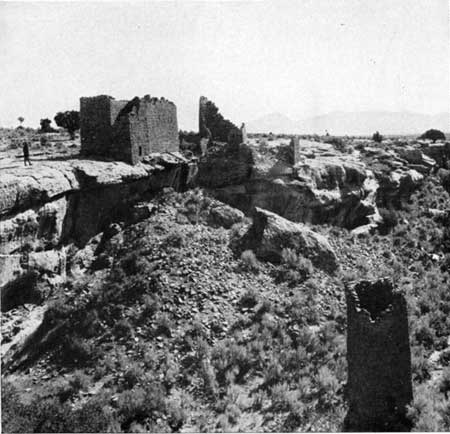![]()
MENU
|
Glimpses of Our National Monuments HOVENWEEP NATIONAL MONUMENT |

Hovenweep ruins.
Photo by George L. Beam.
Four groups of remarkable prehistoric towers, pueblos, and cliff dwellings are contained in the Hovenweep National Monument, which was created March 2, 1923. Two of these groups in Hackberry and Keely Canyons are in Colorado; the Ruin and Cajon Canyon groups are across the State line in Utah. Hovenweep is an Indian word meaning "deserted valley." The area of the monument is 286 acres.
In the Ruin Canyon cluster there are 11 different buildings, the largest of which, Hovenweep Castle, has walls that measure 66 feet long and 20 feet high. Besides towers and great rooms, this building has two circular kivas, or men's ceremonial rooms, on the east end, identical in construction with those in ruins on the Mesa Verde National Park. The towers, distinctive features of the Hovenweep ruins, are rectangular, circular, semicircular, D-shaped, and oval, and generally are two or three stories high. Some have single rooms while others have multiple chambers, the latter being a unique type not found elsewhere. Unit Type House, a pueblo, having a single centrally placed kiva, compactly surrounded by rectangular rooms, is a pure type pueblo.
In the Keely Canyon group five large buildings cluster around the rim of a spur of the canyon or are perched on angular rocks at its base. Even to-day, after centuries of wear, they show fine masonry, although some of the mortar between the courses of stones has been washed out. There are small cliff houses in the walls of the canyons below most of the great houses.
One of the buildings in the Hackberry Canyon group is called the Horseshoe House by reason of its shape. The ruin has two concentric walls, a curved outer wall on the north separated by about 4 feet front an inner circular one and united to it by two radial partitions forming compartments still well preserved. The height of the outer wall is 12 feet; that of the inner somewhat less. Half-fallen walls of a cliff dwelling of considerable size are found in a cave situated below this building, and upon a neighboring point stands a square tower with high walls and carved corners.
The Cajon Canyon group includes a number of important antiquities. The several multiple-chambered towers of the Hovenweep Monument belong to a prehistoric type distinct from pueblos, for nothing is found in modern pueblos comparable to them. They do not suggest habitations, for they would hardly accommodate the number of workmen necessary to build them. Their general appearance suggests granaries, forts, castles, or some communal use, possibly religious. Then, too, they are sometimes too shut in by surrounding cliffs to serve as watch towers and are accompanied by cliff dwellings which show evidences of habitation. Whatever their use, they are a specialized architectural type and apparently localized to this section.
The Hovenweep Monument lies about 50 miles west of the Mesa Verde National Park, and since there is no resident custodian the superintendent of that park assists in its administration. It is, however, under the general supervision of the superintendent of southwestern monuments. Each of the four groups of ruins is situated within a mile of the main-traveled road between Dolores, Colo., on the Denver & Rio Grande Western Railroad, and Bluff, Utah. The ruins are accessible by automobile, and a side trip may be easily made to them in connection with a visit to Mesa Verde Park.
|
|
Last Modified: Thurs, Oct 19 2000 10:00:00 pm PDT
glimpses2/glimpses15.htm

 Top
Top